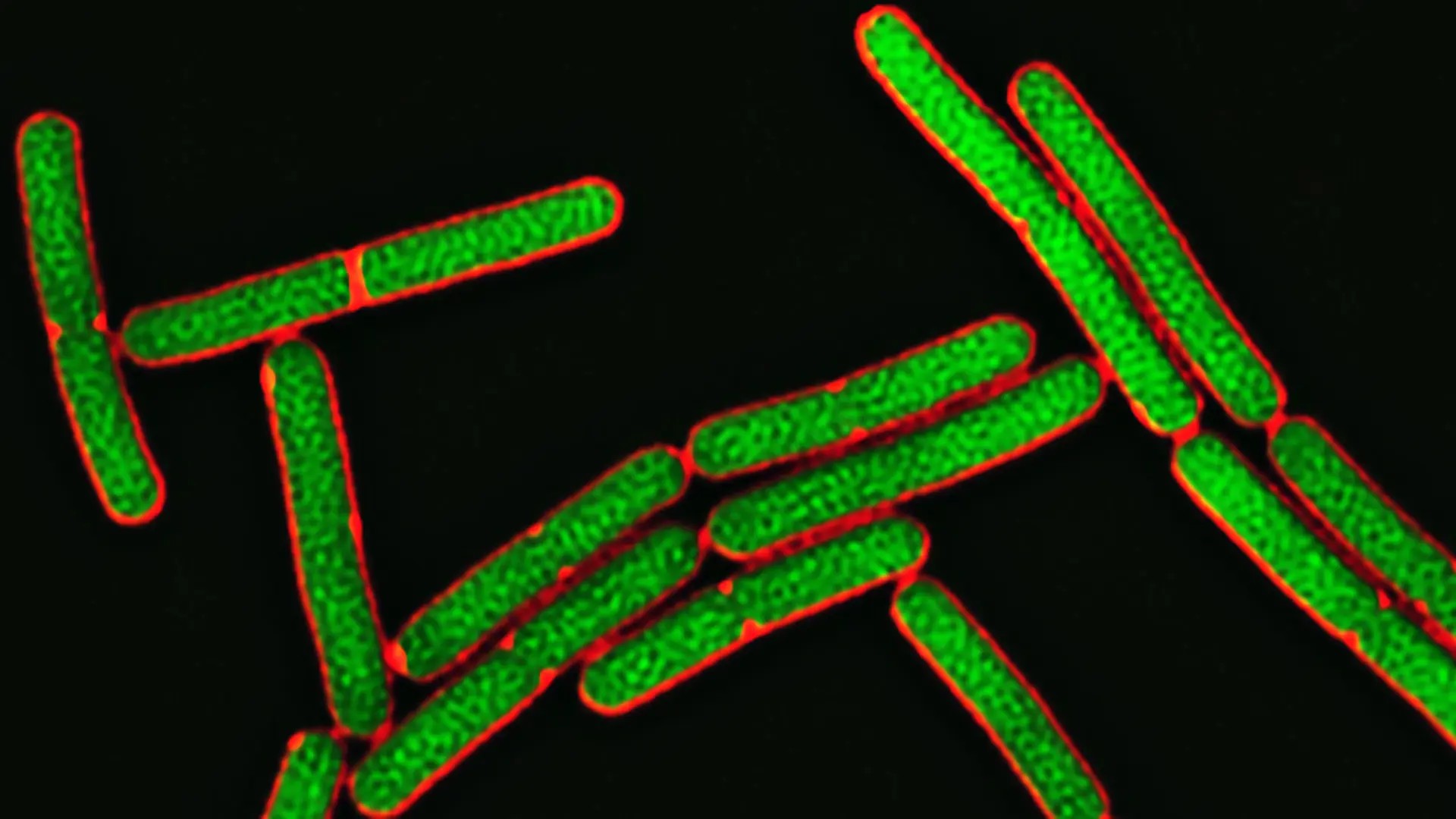
Michaela Wenzel’s group studies the molecular mechanisms of antibiotic action and resistance in living bacteria with a focus on the cell envelope. The major aim is to improve the fundamental knowledge of how antibiotics interact with bacterial cells, which is pivotal to develop more sustainable antibiotics and novel antibacterial strategies.
The antibiotic resistance crisis
The discovery of antibiotics, heralded by compounds like salvarsan, penicillin, and gramicidin, revolutionized modern medicine and formerly deadly diseases became easily treatable. However, this privileged situation could change drastically over the next years. Bacteria possess a remarkable genetic capability to adapt and become resistant to existing antibiotics.
Only few new antibiotics have been developed in the past decades, which makes it increasingly difficult to keep up with the emergence of resistant bacteria. To prevent a fallback into a pre-antibiotic era, we need to advance antibiotic discovery and minimize the development and spread of antibiotic resistance.
The bacterial cell envelope
The key to antibiotic sustainability is to develop substances that leave little possibility for bacteria to adapt and become resistant too fast. One strategy to achieve this is to target the bacterial cell envelope. This complex structure, which consists of one or two lipid membranes and a cell wall composed of sugars and amino acids, separates the cell from the outside environment.
An intact cell envelope is essential for bacteria to survive, and its complexity largely precludes spontaneous resistance mutations. Moreover, changes in cell envelope structure are often poorly tolerated, which leaves less room for bacteria to develop resistance.
Antibiotics that impair cell envelope functions, such as penicillin, are very successful in treating infections. However, only a tiny fraction of possible cell envelope targets is currently exploited, leaving plenty of unused potential.

Research lines
In our group we work on research projects related to understanding antibiotic mechanisms of action and resistance. We characterize how antibiotics kill bacterial cells and how bacteria defend themselves against antibiotic attacks. We are interested in both fundamental research questions and new approaches for antibacterial therapy. Our main focus lies on the cell envelope as interface between antibiotic action and stress response, but we also run projects on DNA damage, protein aggregation, and microbial biosynthetic processes.
Antimicrobial mode of action studies
Our understanding of how antibiotics kill bacteria on a cellular level is still very limited, which is a serious knowledge gap. Antibiotic mechanisms have often been viewed under the premise of specific, single targets. However, there is increasing evidence that antibiotics inhibit bacteria on multiple levels. For example, established antibiotics like daptomycin and tetracycline have different mechanisms than previously thought and interact with unprecedented additional targets.
In this research line, we investigate the influence of a variety of antibiotics with diverse targets on bacterial cells using advanced fluorescence and electron microscopy, spectroscopy, and mass spectrometry techniques. With this research, we not only contribute to the fundamental understanding of antibiotic action but also create phenotypic reference profiles of a variety of mechanisms that can be used in comparative mode of action studies of novel drug candidates.
Using stress response and phenotypic reference profiles, we investigate the mechanisms of action of novel antibacterial drug candidates, lead structures, and nanomaterials, for example, the plant-derived antibiotic rhodomyrtone or natural and synthetic antimicrobial peptides. We are using Gram-positive, Gram-negative, and mycobacteria as models and are now also delving into antifungal mode of action studies.
We are always interested in collaborating on new exciting compounds!
Antibiotic potentiators
The second pillar of our research is the reaction of bacterial cells to antibiotic exposure. We want to understand how bacteria adapt and become tolerant or resistant. Thereby, we are mostly interested in phenotypic and intrinsic antibiotic resistance.
The most important structure that confers intrinsic antibiotic resistance is the outer membrane of Gram-negative bacteria. This structure strongly restricts the access of antibiotics to their targets, which typically sit in the inner membrane or the cytoplasm of the cells. As a consequence, Gram-negative bacteria are generally much more resilient against antibiotics than Gram-positive bacteria, which lack an outer membrane. Thus, only few antibiotic classes are available for treating infections with Gram-negative pathogens. Aggravated by the spread of acquired antibiotic resistance, this leaves very limited treatment options for infections with Gram-negative bacteria.
In this research line, we examine novel strategies to overcome this intrinsic resistance-conferring barrier using Escherichia coli as a model organism. We also apply similar principles to mycobacteria, which are evolutionarily closer to Gram-positive bacteria but practically pose the same problem to drug development as Gram-negative bacteria, because their impermeable mycolic acid layer acts as an analogous outer barrier.
We also explore different adaptive stress response mechanisms that are induced by antibiotic stress. We investigate their mechanisms and how they support bacterial survival during antibiotic exposure. In addition to these basic research questions, we evaluate stress response proteins as accessory antibiotic targets for developing novel types of antibiotic potentiators.
Membrane organization
The major interface between bacterial cells and their environment is the cytoplasmic membrane. This is the surface, where cells sense external stress and induce appropriate adaptation mechanisms. Bacterial membranes have long been viewed as uniform lipid bilayers following the classic fluid mosaic model. However, we now know that they contain distinct microdomains that fulfill specific functions in membrane physiology.
Our group is mainly interested in a recently discovered type of membrane microdomain that is characterized by high membrane fluidity and involved in the synthesis of the bacterial cell envelope. We want to know more about the nature and relevance of these domains and approach this problem from different angles, including medical, environmental, and agricultural viewpoints. In particular, we investigate their involvement in antibiotic mechanisms, antibiotic and environmental stress responses, and virulence.

Collaborations
Our group collaborates with many partners around the globe. We are always looking for new techniques suitable for our research questions as well as for new interesting compounds for mode of action studies.
Please direct requests for new collaborations to wenzelm@chalmers.se.

Group members
Research group leader
Postdoc
Visiting researchers
Project assistant
MSc student
Want to join our group?
Vacancies
All open positions in our group will be announced through Chalmers vacancies.
If you want to join our lab as PhD student, please also check out the yearly call for excellence PhD positions through the Area of Advance Nanoscience and Nanotechnology. The selected candidates are awarded with a PhD-position, which they can freely place at any Nano research group at Chalmers, including our lab.
Find the current call here.
The nano excellence PhD positions are a recurring call that opens yearly in December with a deadline in March. If you miss a deadline, please check back in the next round!
To inquire about upcoming vacancies or the possibility to apply for an external postdoc fellowship contact wenzelm@chalmers.se.
Thesis projects
Background
To prevent a fallback into a pre-antibiotic era, we need to advance antibiotic discovery and minimize the development and spread of antibiotic resistance. In order to achieve this, it is essential to understand the molecular mechanisms underlying the activity of antibiotics and the countermeasures that bacterial cells employ to acquire tolerance or resistance to antibiotic drugs. This knowledge is pivotal for developing new drugs and alternative treatment strategies.
A typical thesis project in our group
We are particularly interested in the bacterial cell envelope, which is not only the barrier that antibiotics need to cross to reach intracellular targets but also an important antibiotic target structure by itself as well as the location of many important stress response systems. We are investigating the role of the bacterial cell envelope as both antibiotic target and location of bacterial countermeasures against antibiotic stress.
Master projects in our group typically focus on novel antibiotic candidates and strategies, on characterizing bacterial resistance factors, or on developing new methods applied in the analysis of antibiotic mechanisms of action and resistance.
Students will approach these projects using advanced cell biological methods, different live cell imaging techniques, fluorescence spectroscopy, genetic, and biochemical methods. Depending on the individual project, in vitro lipid and protein assays, single molecule imaging, and -omics approaches might be employed as well.

How to find your thesis project
Currently available Master thesis projects can be found in the Thesis Portal. You can also always send an inquiry to us independently of advertised projects!
We generally recommend 60 hp thesis work, because this gives students more time to really develop their projects. We will also consider 30 or 45 hp, yet not all projects are suitable for shorter theses.
Master thesis projects are usually individual projects, but group projects can be discussed depending on the individual program requirements.
Starting dates are flexible, but usually Master projects start in January and August.
A background in a biological discipline is a merit but we will consider interdisciplinary applicants on a case-by-case basis. Even collaborative theses with another lab or department are possible. International students are always welcome.
All projects are designed to be performed on-site. If you are interested in a remote thesis project, please contact us for possibilities.
If you are looking for a Bachelor or short-term student project, e. g. in an Erasmus student exchange, please contact us directly for available slots and projects.
Contact: wenzelm@chalmers.se
Alumni
A lot of talented people have worked in our lab so far. From experienced postdoctoral researchers to students doing their first project work, all our alumni are listed below.

Postdocs
Luna Baruah (2020-2023)
Rupa Rani (2022-2024)
Gabriela Marinho Righetto (2022-2024)
PhD students
Ireny Abdelmesseh Nekhala Abdelmesseh (2021-2022)
Ann-Britt Schäfer (2019-2024, now postdoc in our group)
Margareth Sidarta (2020-2024)
Master students
Charitha Sai Penumudi (2020-2021)
Jonatan Norborg (2020-2021, now PhD student in our group)
Anuntxi Monsalve Inguiniz (2021)
Pauline Hammer úr Skúoy (2021-2022)
Priyanka Rawat (2021-2022)
Pragya Kamal (2021-2022)
Ana Isabel Lorente Martín (2021-2022)
Hashlin Pascananda Utami (2021-2022)
August Qvist (2022-2023)
Johanna Carlson (2022-2023)
Shubhda Dev (2023-2024)
Estelle Lucienne Dominique Prüske (2023-2024)
Padmanabhan Manoj (2024)
Bachelor students
Ingrid Brännud (2020)
Julia Stevrell (2020)
Louise Stauber-Näslund (2020)
Mikaela Sjögren (2020)
Emelie Karlsson (2020)
Gabriel Nordblom (2020)
Olivia Johnsson (2022)
Emma Frisk (2022)
Aline Carvalho Nestgaard (2022)
Izabela Domagala (2022)
Oskar Blomqvist (2022)
Johannes Panagiotidis (2022)
Elisa van Leuven (2023-2024)
Visiting researchers
Coralie Bianco (2020)
Arda Şems (2020)
Alizé Mouchard (2020-2021)
Kayla Nelin Sezer (2021)
Dilan Nisa Yilmaz (2021)
Paula Didelot (2022)
Lisa Doki-Thonon (2022)
Rahel Schaak (2022)
Aniqa Naeem (2022)
Mokshada Varma (2023, now postdoc in Elin Esbjörner’s group)
Aysha Arshad (2023)
Rajarajeshwari Ramamoorthy (2023-2024)
Lilli-Joelle Köhler (2024)

Outreach activities and media coverage
- Tackling Antifungal Resistance: RAFT Project Secures Major Grant
- Microorganisms in the spotlight of Swedish Research Council grants
- New Research Explores Treatment Strategies for Tuberculosis and Antibiotic Resistance
- Bacterial defense mechanisms targeted for treatment
- Margareth Sidarta investigates bacterial defense mechanisms as targets for treatment (from Chalmers intranet)
- Klass 8 fick lära sig om antibiotikaresistens på Chalmers (article in Swedish)
- Joining efforts in research on antibiotic resistance
- Scholary Community Encyclopedia entry on bacterial mechanosensitive channels
- Strategi alternativ melawan bakteri super (presentation in Indonesian, Margareth’s presentation starts at 00:58:58)
- New mechanism of antibiotic tetracycline discovered
- New mechanism of tetracycline discovered
- Hälsosam bakterieflora skapar jord i balans (article in Swedish)
- Membranaktive Antibiotika: Neue Mechanismen gegen ein altbekanntes Ziel (article in German)
- Five questions for Michaela Wenzel (from Chalmers intranet)








